Innovative Uses of AI and ChatGPT in Content Creation
In 2024, the #1 use of AI and ChatGPT in content creation is the ability to assess content quality for things such as spelling, grammatical errors, and even the flow of the content.
I still vividly remember the day I stumbled upon an article that boldly claimed, "AI will replace writers in the next decade!" As a content creator who had weathered numerous evolutions in the digital landscape, this seemed improbable and mildly terrifying. Content creation is an art, I thought, requiring a human touch, empathy, and understanding that no algorithm could replicate. Yet, as AI, specifically ChatGPT, started making waves across industries, including mine, I couldn't help but be intrigued by its potential impact on my career.
Click on each corresponding link to jump ahead:
- A Skeptic's Journey Into the Unknown
- Taking the Plunge
- AI as a Creative Ally
- The Tools That Turned Skepticism Into Belief
- Harnessing the Full Potential
- Advocating AI to Companies
- Things To Keep In Mind When Using AI Tools
- An Open Letter to the Skeptics
For more information about how you can implement AI into your business, contact us.
1) A Skeptic's Journey Into the Unknown
My initial skepticism wasn't unique. Many colleagues echoed my concerns, sharing tales of news stories and expert opinions prophesying a future where machines overshadowed human creativity. "Will AI take my job?" became a recurring theme in forums and discussions within the writer community. This posed an existential threat to what I cherished most—creating stories and content that connected with people on a personal level.
2) Taking the Plunge
Curiosity, coupled with a desire to stay ahead in an ever-evolving industry, led me to dive into the world of artificial intelligence and ChatGPT.
My rationale was simple: if this technology were to play a significant role in content creation, understanding and mastering it would be crucial to maintaining relevance in my field.
The introduction of ChatGPT and other AI tools into my work process was nothing short of revolutionary.
Despite what I had feared, these technologies helped me become more creative rather than being a limiting factor. I was able to devote more time to creative thinking and content refinement that would allow me to better connect with readers.
How exactly? Well, ChatGPT helped me in various ways I didn’t expect it to.
Brainstorming Ideas:
Every great piece of content starts with an idea. Yet, brainstorming can often feel like trying to start a fire without kindling. ChatGPT became my digital spark.
I can give it a topic or keyword, and it comes up with a lot of ideas and angles for my pieces. It is like having a thinking partner who is available all the time. It keeps my creativity flowing and makes sure I never run out of ideas.
For example, if I have to write an article about solving customer retention problems in the e-commerce sector, I should include useful tips that e-commerce shop owners can use to maintain their customers.
These tips must be realistic, attainable, and, of course, make sense. Despite being good at researching various topics, my experience in the retail sector and its intricacies are limited.
So what do I do? Well, I pop the question to ChatGPT. First, I open ChatGPT Playground and fill out the “System” section with my prompt and specific instructions.
Then, in the “User” section, I add my question; "What are unique ways to solve customer retention problems in the e-commerce sector?”
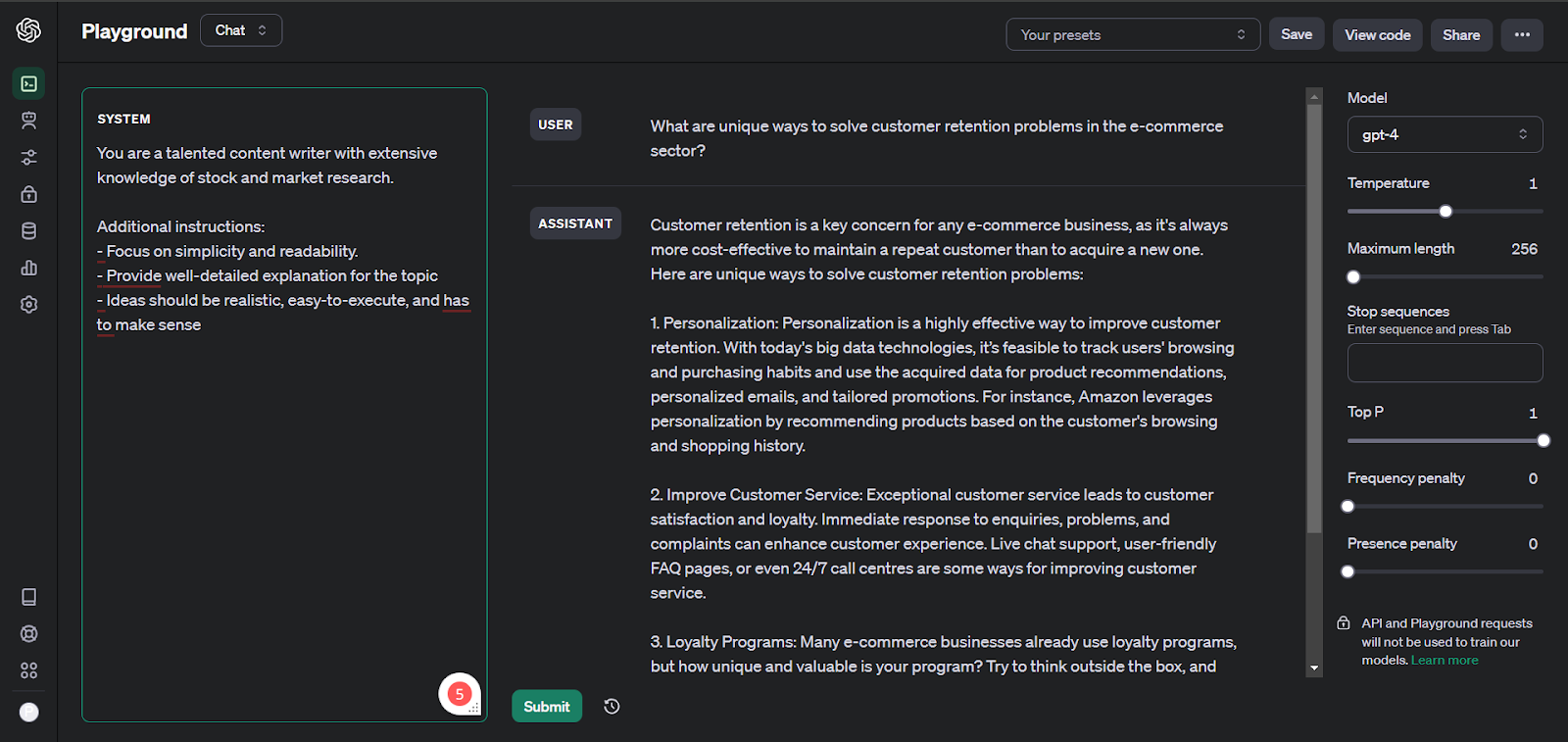
As you can see, ChatGPT gave me a list of methods to solve customer retention problems. I can then research these methods and expand the discussion of each in my article.
Doing Research:
In the past, research felt like diving into an ocean of information, not knowing if I'd surface with pearls or pebbles. AI tools have turned this daunting ocean into a manageable swimming pool.
The process for doing this is similar to using ChatGPT to brainstorm ideas. To start, you need to write your prompt in the “System” section of Playground.
For example, I want to write about technology in the food delivery industry. Traditionally, I would have to browse through search results on Google to find a list of these technologies.
Now, all I have to do is write my question in ChatGPT; “What are the emerging technologies in the food delivery service industry, and how are they changing business models?”
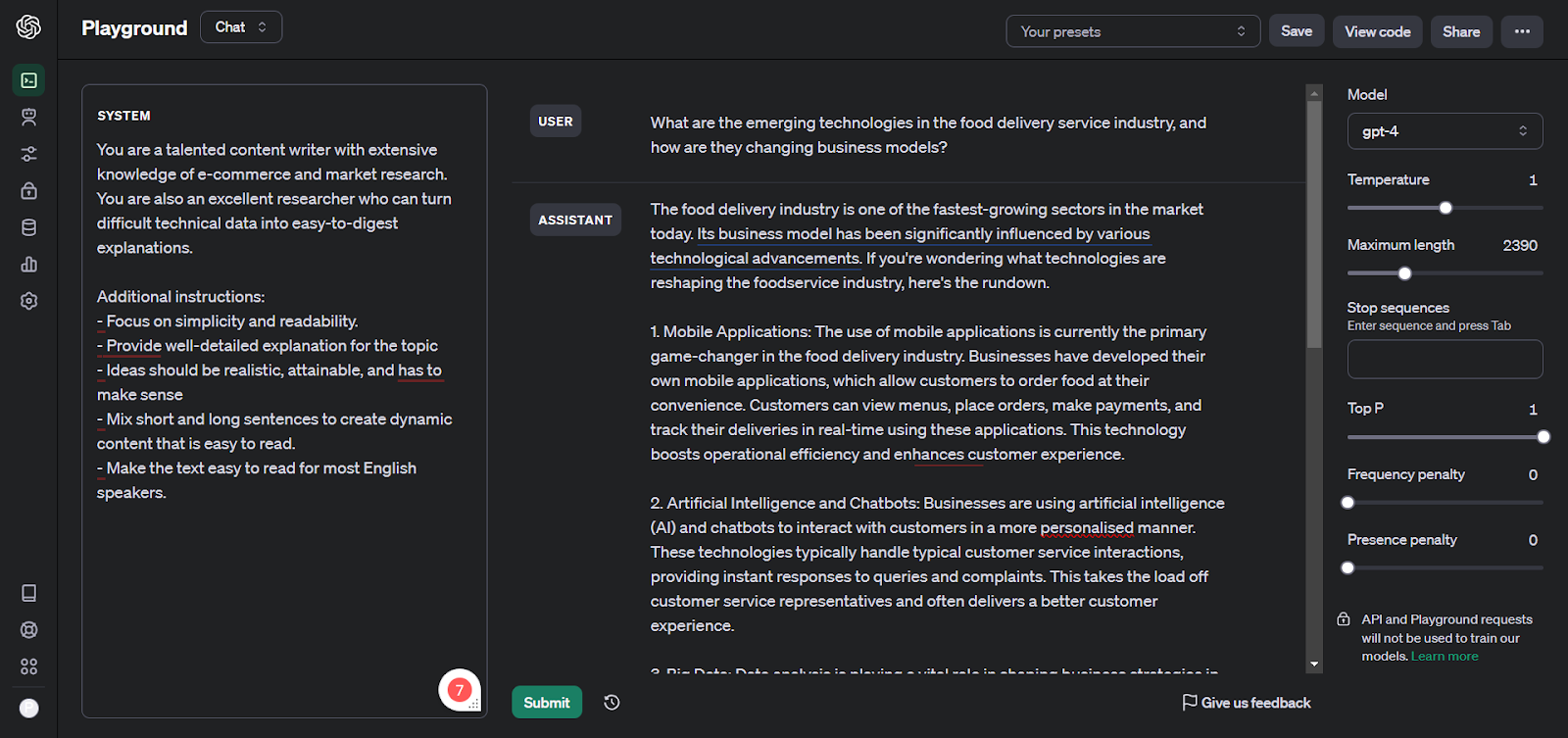
ChatGPT then gives me a short, relevant list of technologies used by the food delivery industry, accompanied by a detailed description of how these technologies are used and their effect on the industry.
Assisting My Writing:
Staring at a blank page is every writer's nightmare. Fortunately, ChatGPT can act as a co-writer.
For example, if I need to expand and improve my discussion about how data analysis can help the food delivery business, I can ask ChatGPT for help by pasting the text I have in the “User” section.
In the “System” module, I’ll write my prompt explaining what I want ChatGPT to produce and also some specific instructions that I want ChatGPT to follow.
As you can see, ChatGPT then produces a longer, more detailed text that I can edit and add to my article.
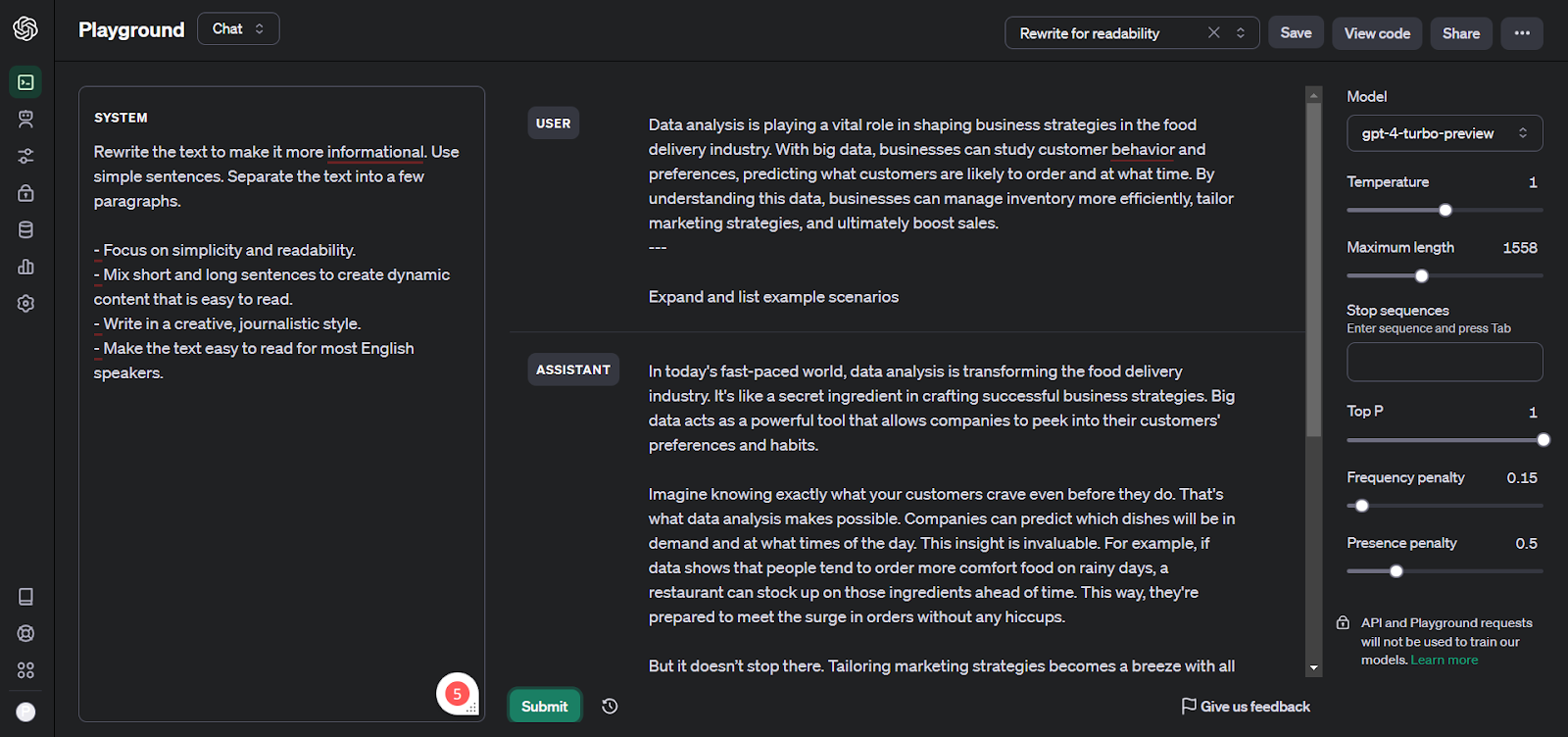
Catching the Devil in the Details:
Editing and proofreading my work used to take so much time. Especially for my long-form content that reaches five to ten thousand words, it was such a headache staring at a block of text, hoping to spot the mistake that would cost me my client’s trust in my skills.
This is where AI steps in to lift the heavy work of editing and proofreading off my shoulders. Grammar checkers are just the beginning; advanced AI tools can suggest stylistic improvements, ensure tone consistency, and predict reader engagement levels.
I use another tool, Grammarly, to improve the tone consistency of the text ChatGPT gave me earlier. Grammarly would then follow my instructions and improve my text for me.
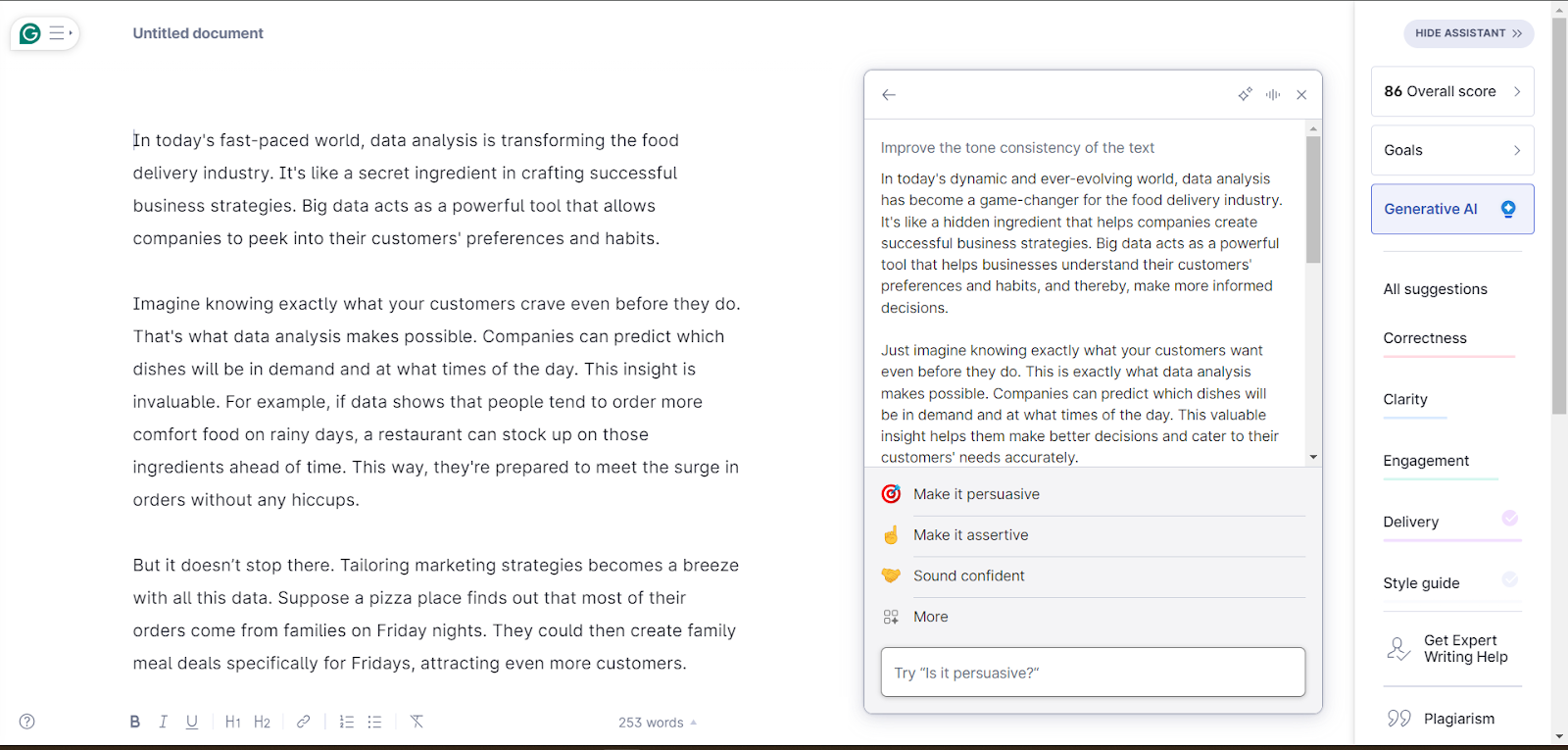
I can also paste the text into ChatGPT and ask it to provide feedback on my work. This feedback is often very helpful and has helped me improve my work.
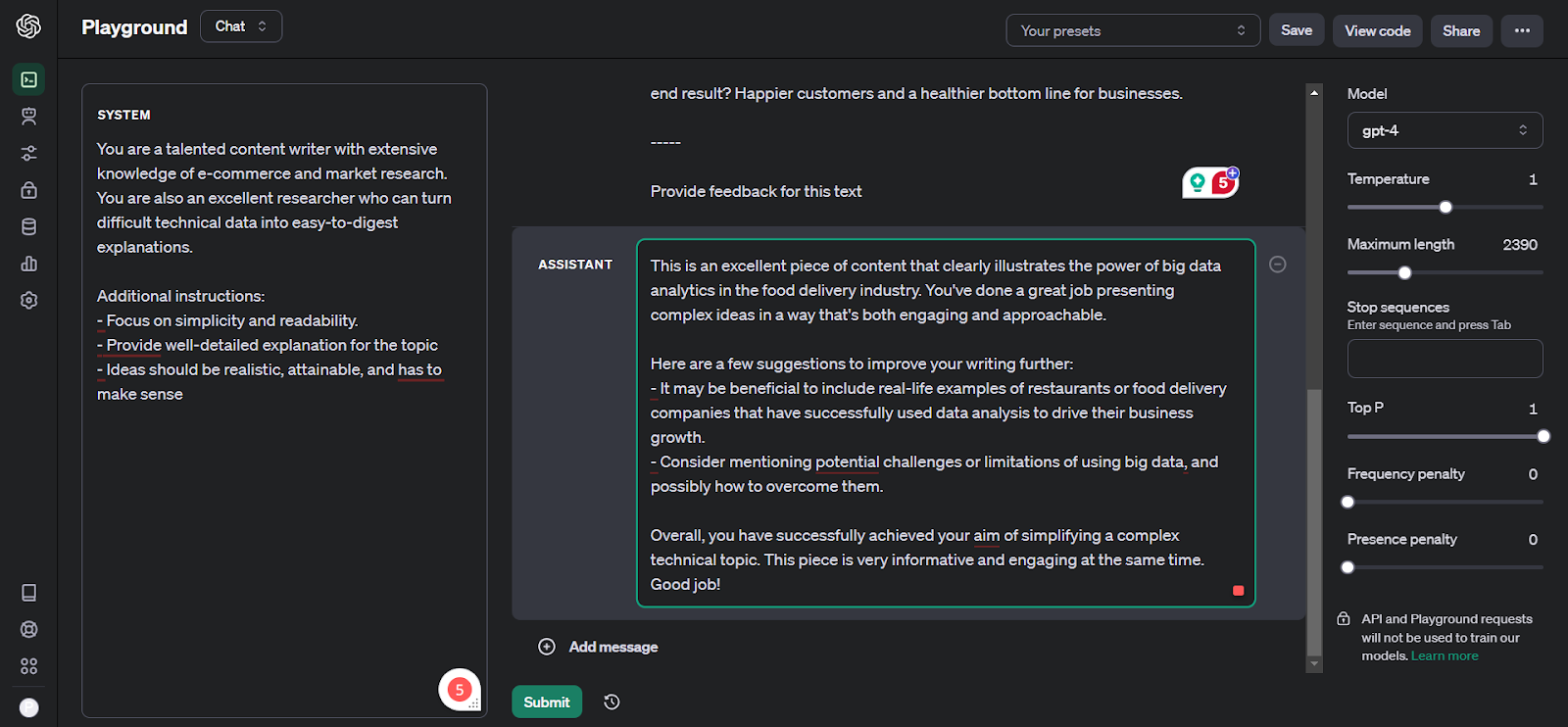
SEO Optimization:
Source: Profitworks
Here again, AI tools have proven indispensable by helping optimize content for search engines.
For example, I can paste my draft article to ChatGPT, and provide my prompt, and a list of keywords that need to be in the article.
ChatGPT provided me with a version of my article with the keywords I listed. I can then edit and proofread this text.
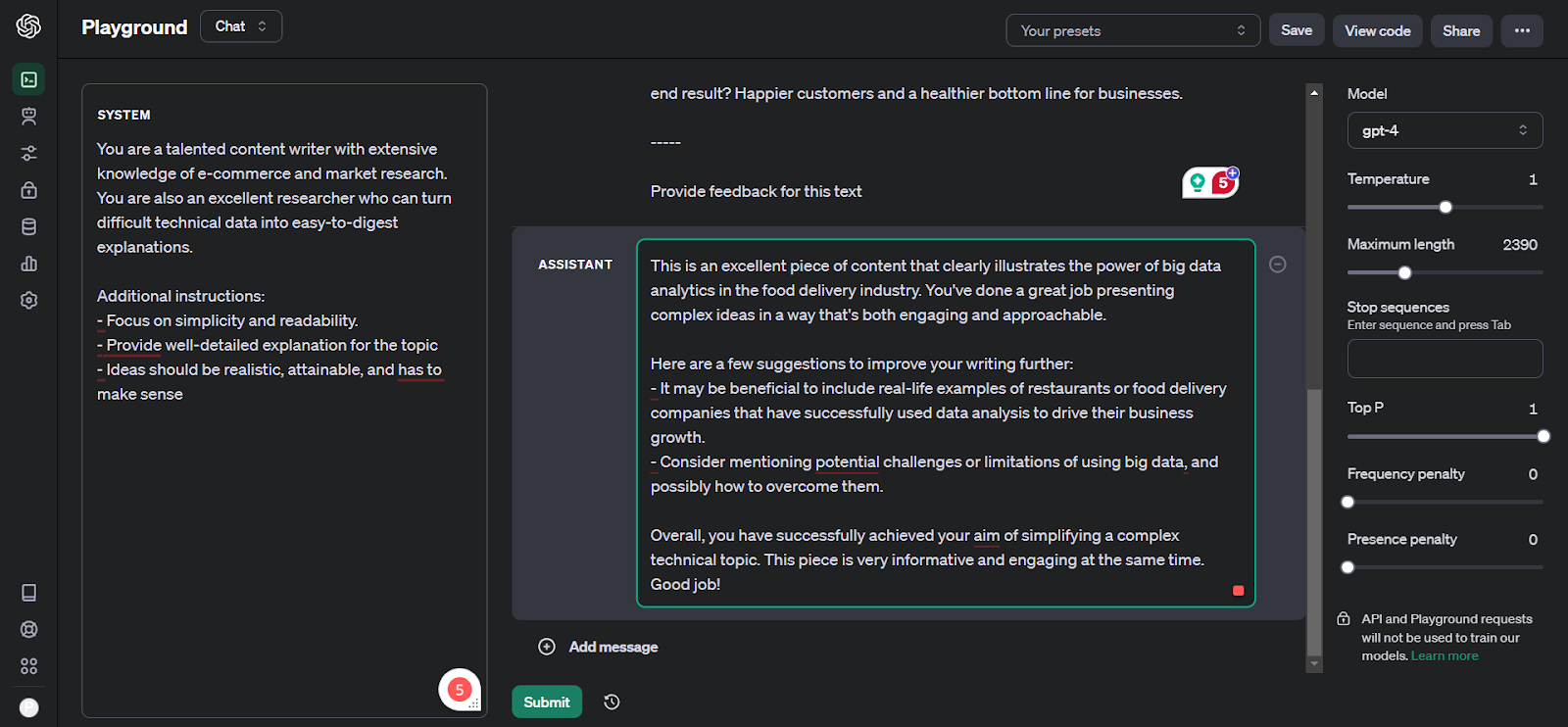
Instead of manually adding the keywords to the text, I can simply ask ChatGPT to assist me in writing them into my existing draft. It's like having an SEO assistant that can help me save time and also ensure maximum online visibility for my article.
3) AI as a Creative Ally
To fellow content creators and business owners navigating the digital landscape: integrating AI into your content strategy isn’t just advantageous; it’s becoming essential. In my journey, ChatGPT and other AI tools have not replaced creativity or craftsmanship; they have amplified them. They’ve made routine tasks more manageable and complex challenges more approachable. Adopting AI in content creation allows us to do more than keep pace; it enables us to set the pace, ensuring our stories not only reach eyes but resonate with hearts.
4) The Tools That Turned Skepticism Into Belief
The evolution of AI technology has given rise to many tools that have simplified the life of a content writer like myself.
Here’s an in-depth look into the AI tools that have significantly transformed how I create content, making the process more efficient and innovative.
ChatGPT: Beyond Basic Drafts
The main protagonist of this article, and the tool that made all of this possible, is ChatGPT. Initially, I viewed ChatGPT as merely a drafting tool. However, its capabilities extend far beyond that. After using it a couple of times, I’ve concluded that ChatGPT is an invaluable tool for writers, assisting us with content creation in various ways and helping us produce high-quality, engaging, and well-researched pieces. It’s also easy to use. Just open ChatGPT in your browser, or better yet, you can also install a ChatGPT Chrome extension for convenience.
Grammarly AI: The Ultimate Editing Companion
Grammarly's AI-driven recommendations go beyond basic grammar checks. This tool offers style and tone suggestions, ensuring my content maintains consistency and clarity. Its ability to suggest synonyms and rephrase sentences has been invaluable in refining my drafts into polished articles that flow seamlessly.
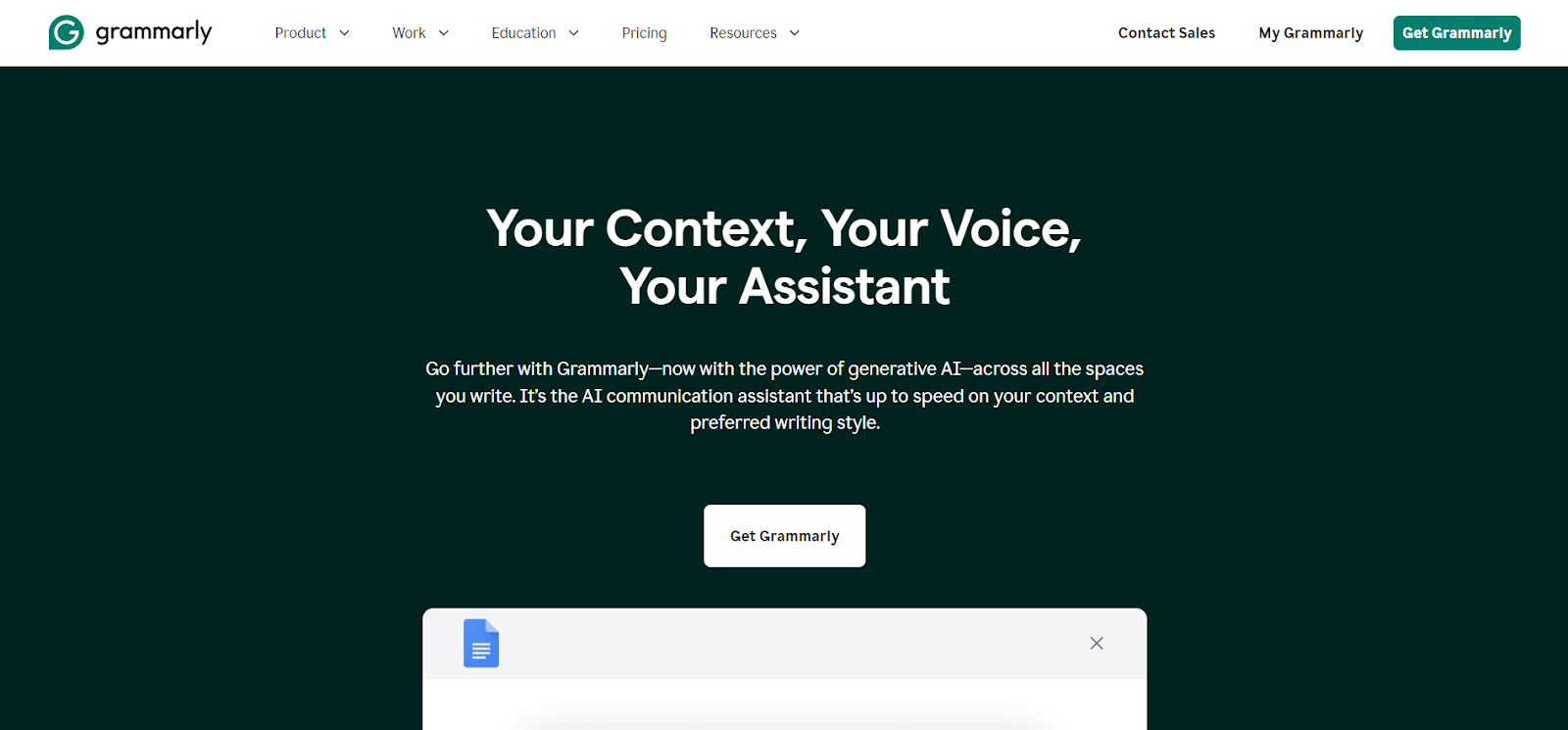
Canva’s Magic Design Tools
While primarily known for its user-friendly design capabilities, Canva’s integration of AI to suggest design layouts has been a game-changer.
Whether it’s selecting templates or choosing colour schemes that align with the emotional tone of my articles, Canva’s AI effortlessly bridges the gap between content and visual appeal.
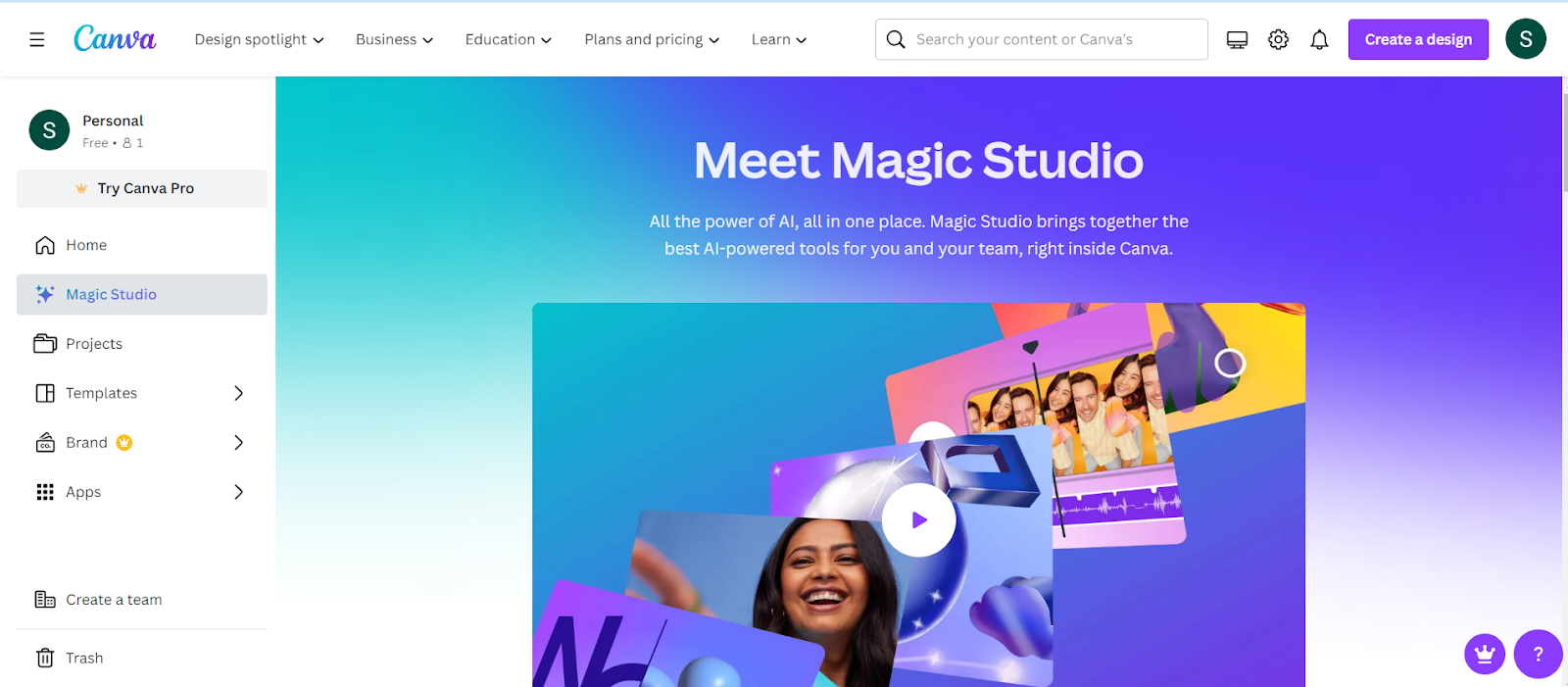
Jasper (Formerly Jarvis)
Jasper stands out for its versatility in generating content across various formats, whether blog posts, social media content, or email campaigns. Its ability to adapt to different brand voices and SEO requirements makes it an essential tool in my content creation toolkit. Jasper's collaboration feature also enables real-time content development with team members, streamlining the editing process.
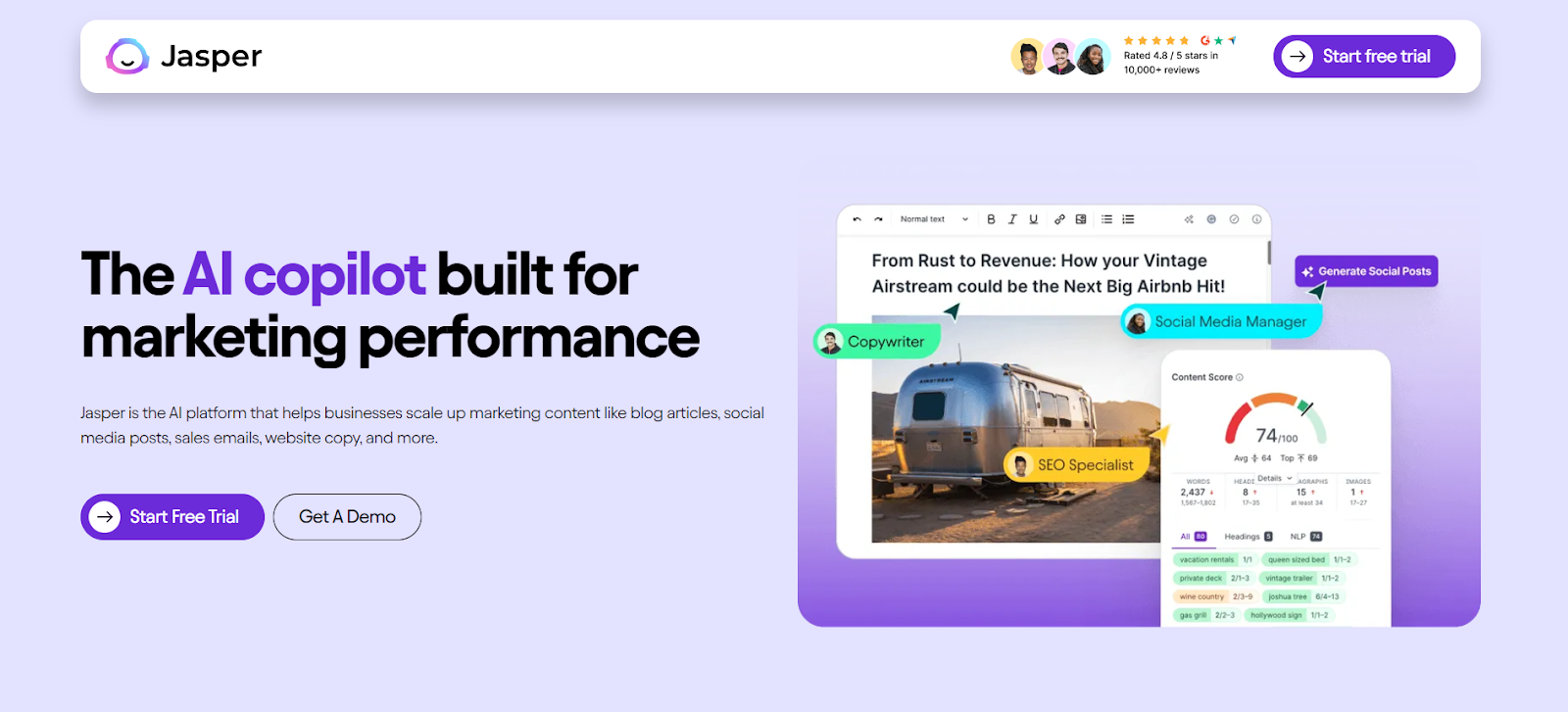
SurferSEO: Optimizing Content for Search Engines
SurferSEO harnesses AI to analyze top-performing content across the web and provides actionable insights on optimizing your own content for search engines. My content has performed much better online by using suggested keywords, enhancing structure, and modifying readability based on its analysis.
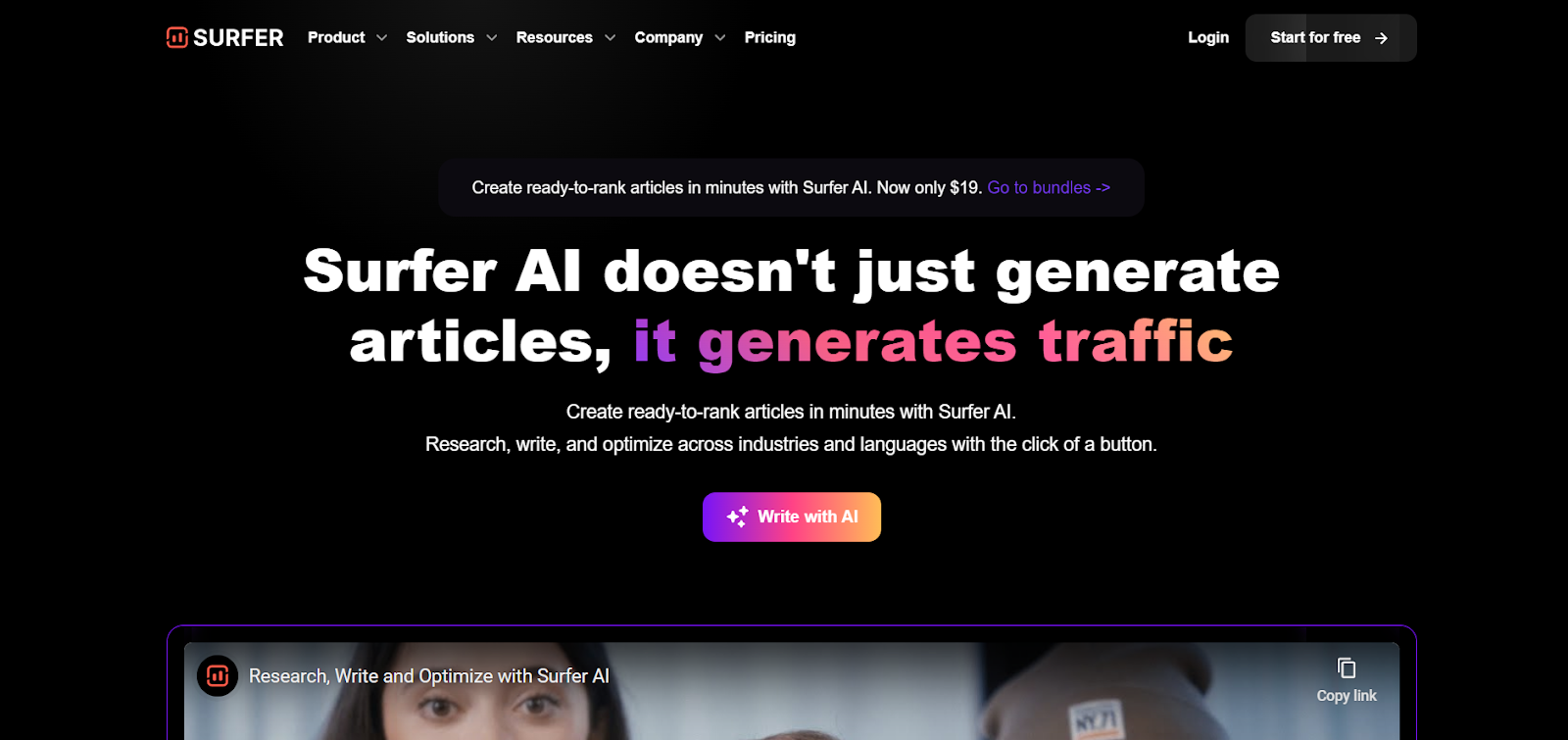
BuzzSumo: Understanding Audience Engagement
Though not solely an AI tool, BuzzSumo utilizes sophisticated algorithms to track content performance across the web. It helps identify trending topics and analyzes what type of content garners the most engagement within specific niches. This intelligence has been instrumental in guiding my content strategy toward topics that resonate deeply with my target audience.
5) Harnessing the Full Potential
These tools represent just a fraction of what's available in the booming market of AI-driven content creation tools.
Each brings unique functionalities to the table, enhancing creativity and efficiency in ways I could hardly have predicted even 3 years ago.
Not only have these tools made my processes more efficient, but they have also improved the calibre of my work. Artificial intelligence technologies have allowed me to focus on adding creativity and strategic thinking to my content—elements that genuinely attract and engage audiences—by taking care of time-consuming duties like research, crafting initial notions, and editing.
6) Advocating AI to Companies
My advocacy for AI in professional settings springs not from a dismissal of human capability but from a profound appreciation for what we can achieve when technology amplifies our creative spirit.
Efficiency and Volume Without Sacrificing Quality
The pressure to consistently produce high-volume content can often lead to burnout among creative professionals, compromising both their well-being and the quality of work produced.
AI steps into this gap as a game-changer, enabling teams to maintain or even increase output without sacrificing quality.
From drafting initial content frameworks to conducting research or ensuring grammatical accuracy, AI handles the heavy lifting, allowing creators more time to refine and enrich their work.
Scaling with Precision and Personalization
AI's learning algorithms have an uncanny ability to tailor content to match the diverse preferences of your target demographic.
For businesses juggling various platforms and customer segments, this means delivering personalized content at scale without overburdening your creative departments.
As my experience has shown, the application of AI in these areas doesn't just maintain quality; it enhances it by ensuring relevancy and engagement, driving your brand's message home with precision.
Embracing Change
The journey from skepticism to advocacy for AI in my professional life underscores a broader narrative relevant to all businesses today: change is inevitable and necessary.
Integrating AI into content creation processes exemplifies how embracing innovation can catapult businesses into new realms of creativity and efficiency.
Those who are on the brink of this digital transformation and are debating whether or not to make the leap should take into consideration the following: artificial intelligence is not just about keeping pace; it is also about setting the pace.
It is about utilizing technology to improve human potential, which will result in more engaging narratives and more profound interactions with your audience.
(image)
7) Things To Keep In Mind When Using AI Tools
As with any powerful tool, AI’s integration must be approached with mindfulness and strategic planning to harness its potential without unintended consequences.
As someone who's navigated this path, I'd like to share some critical considerations that should guide your journey with AI in professional settings.
Ethical Use and Transparency
First and foremost is the commitment to ethical use and transparency. With great power comes great responsibility, and AI is no exception.
Acknowledging the source of your AI-generated content or assistance when relevant is crucial. This fosters trust with your audience and upholds the integrity of your work.
Ethical use also extends to the data powering your AI tools—ensuring privacy, consent, and respect for intellectual property rights are paramount.
Balance Human Creativity and AI Assistance
Despite AI's efficiencies, it’s essential to remember that it serves as an assistant to human ingenuity, not a replacement.
The unique insights, emotional depth, and cultural nuances that human creators bring to the table are irreplaceable.
Striking a balance where AI handles repetitive tasks or initial drafts while humans refine and inject creativity ensures that content maintains its soul and resonance with audiences.
Continuous Learning and Adaptation
AI technology is always changing, and so should how we understand and use it. Key things are to stay up to date on the latest developments, know the pros and cons of different AI tools, and be willing to keep learning.
This dynamic approach allows us to adapt our strategies in response to new advancements, ensuring that our use of AI remains effective and innovative.
Understanding Audiences' Perceptions
It’s also vital to gauge and understand your audience's perception of AI-generated content. Different demographics might have varying levels of acceptance or skepticism towards it.
Engaging with your audience, seeking feedback, and conducting experiments can help understand their preferences, tailoring your use of AI to enhance rather than detract from their experience.
Do Quality Control
AI's efficiency doesn't negate the need for rigorous quality control. While tools like ChatGPT can generate compelling content drafts, every piece should undergo thorough review and refinement by human eyes.
This ensures that the final output aligns with your brand's voice, meets quality standards, and genuinely connects with your audience.
Prepare for an Adaptive Workforce
Integrating AI into content creation processes necessitates preparing your team for change. Offering training sessions, fostering an adaptive culture, and encouraging team members to explore and experiment with AI tools can smooth this transition.
It’s about equipping your workforce with new skills and mindsets that complement the evolving landscape, thereby securing a competitive edge.

The Risks of Overdependence
Lastly, it is easy to be amazed by what AI can do, but it is important not to become too dependent.
When writing, it is important not to rely too much on AI, since that can stop you from being creative and help you learn important writing skills.
If writers rely too much on AI tools, they might miss out on the chance to develop their own style and story-telling skills.
Finding the right balance between using AI to help you and staying close to your work is important if you want to keep growing and changing as a writer.
8) An Open Letter to the Skeptics
If you are worried about the rise of AI in creative areas, like I was, please do not see these tools as enemies. They are not here to take our places; instead, they are here to make our skills stronger so that we can push the limits of our work and find new opportunities. Yes, AI is still very young and changing every day. This means that it can grow and get better based on what we, the end users, say. There is still a lot of doubt about the future. There will be more changes in technologies, maybe even faster ones. People, on the other hand, are amazingly flexible. From the simple wheel to the complicated algorithms of AI, we have always changed our tools and ideas to make them better. As I reflect on my journey from skepticism to advocacy for AI in content creation, I believe there's much ground for optimism. My experiences may differ from others, but therein lies the beauty of this profession—our diverse perspectives contribute to a richer tapestry of content that can truly impact lives. In embracing AI tools like ChatGPT, we're not edging towards obsolescence but rather stepping into a realm of uncharted potential. While the path forward may be uncertain, our innate creativity and adaptability as humans assure me that we will always find ways to leverage these advancements for our collective benefit. To my fellow content creators and business owners wrestling with the idea of integrating AI into your processes—consider giving it a chance. You might just discover, as I did, that these tools are invaluable allies in our quest to captivate and engage audiences worldwide.
For more information, Contact Profitworks:

